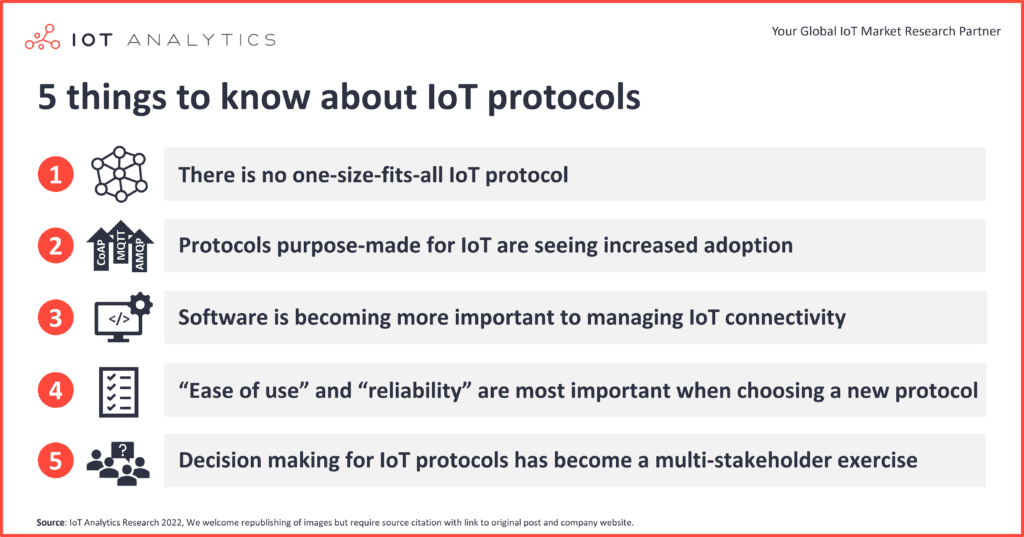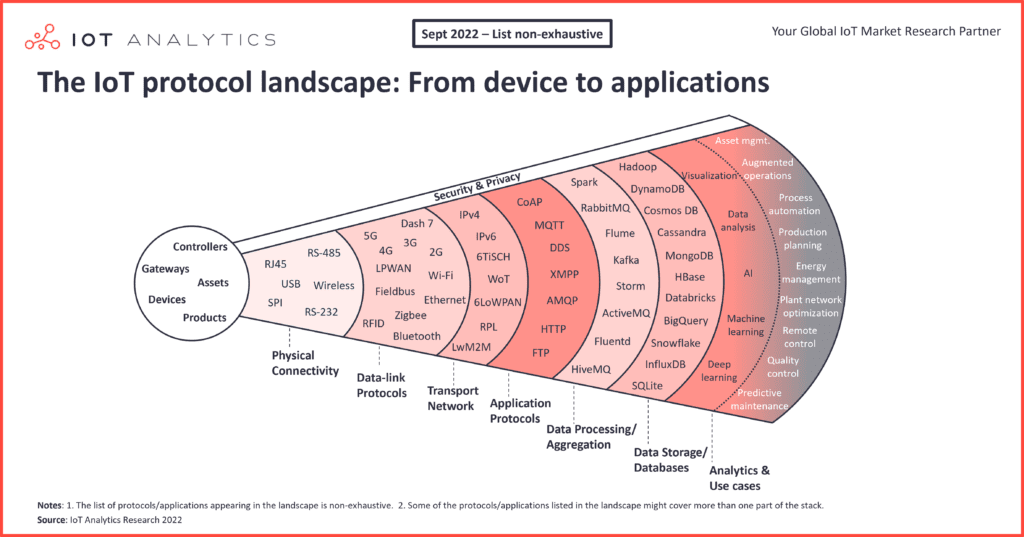5 Key Takeaways About IoT Protocols
5 Key Takeaways About IoT Protocols
- Last Updated: December 2, 2024
IoT Analytics
- Last Updated: December 2, 2024



There are 12.2 billion active global IoT connections at present. Therein lies the power of IoT. A myriad of interconnected devices communicate with each other and produce meaningful data. But being connected is not enough for the devices to communicate. They need to speak the same “language.” That is where IoT protocols come in. A protocol is a set of rules that enable the effective communication (i.e., data exchange) of distinct machines/devices in a network setting. The concept is similar to the languages that we use to communicate. If two people don’t speak the same language, the exchange between them will not be effective. Without these protocols, a digital Babylon would arise. For the IoT Communication Protocols Adoption Report 2022, IoT Analytics surveyed 200 senior decision-makers on their IoT connectivity setup. Here are five takeaways that paint a picture of the IoT protocol landscape in 2022.
'The rise of IoT is bringing along radical changes in how devices communicate with each other, and IoT protocols will only increase in adoption and importance as the number of connected devices increases.' -IoT Analytics
IoT Protocol Takeaways

#1: There is No One-Size-Fits-All IoT Protocol.
There is no undisputed, standard IoT protocol today. That is where the complexity of the topic begins. This fact is also evident in that 73 percent of our survey respondents noted that managing various data formats and protocols inhibited them from scaling their projects. The IoT market, as a whole, is fragmented, and IoT protocols are no different. There is no global standard. Some protocols dominate specific industries (e.g., CAN is a staple in-vehicle component communication, DNP3 is most often used in utilities, and HART is the prevailing protocol used in process industries).
Still, for most projects, the protocol choice can make or break a proper network, and many requirements should be considered. For example, MQTT and NB-IoT (LPWAN standard) are compatible and can work together without flaws in a stable network. However, add a poor reception environment, and that is where the trouble starts. Are the devices battery-powered? How big is the transferred data volume? Is the network stable? Is there a need for messages to have a priority? These are just some questions that need answering before a decision is made. Zooming out, one can recognize the vast “ecosystem” that IoT protocols are a part of.
As can be seen from the image below, the IoT protocols landscape can be quite intimidating. It involves multiple layers that need to be compatible with each other. The communication protocol layers (e.g., connectivity, link, transport, session) constitute only the base of the landscape. Above them, there is data processing (e.g., Kafka, RapidMQ), storage (e.g., MongoDB), and the corresponding applications (e.g., machine vision and asset management).

#2: Protocols Purpose-Made for IoT Are Seeing Increased Adoption.
Based on our research, the share of connections using protocols that have been purpose-made for IoT setups is expected to increase by +11 percent within the next two years. MQTT and CoAP are the protocols leading this growth. Both of them fit the requirements of IoT networks in all respects. They are lightweight (low energy consumption is crucial for battery-powered devices), have a low overhead (smaller message size), and can work in lossy networks (many IoT devices such as sensors can be part of remote setups). For connections between assets/devices to middleware, MQTT is expected to have a +29 percent increase in its connection shares during this timeframe. However, between middleware and applications, CoAP is the IoT protocol expected to grow the most, with a +30 percent increase within the next two years. AMQP should also be mentioned here as another necessary IoT protocol on the rise, showing an overall growth in both connection types.
#3: Software is Becoming More Important to Managing IoT Connectivity.
This rise of IoT protocols has increased software’s importance as a part of the connectivity setup. The connectivity landscape was much simpler 10–15 years ago. Most projects were condensed on-premises (including analytics and visualization). In the meantime, new pieces of software emerged to manage this connectivity. Tools like IoT platforms, brokers, protocol converters, and other such middleware are the pieces that complete the connectivity puzzle. As expected, when it comes to IoT platforms, most respondents are leveraging Microsoft Azure IoT and AWS IoT. Regarding brokers and protocol converters, the landscape is more diverse, and multiple companies are taking the spotlight. For example, HiveMQ and ActiveMQ are two popular brokers, and PTC Kepware and Matrikon are among the most used protocol converters.
#4: “Ease of Use” and “Reliability” are Most Important When Choosing a New Protocol.
Finding the correct IoT protocol for each project’s needs is vital. For example, MQTT is more centralized and better suited for low-bandwidth, remote location connections. In contrast, DDS is decentralized, more versatile, and can accommodate high-performance networks. Hence, it is essential to compare the potential IoT protocols and their attributes. According to IoT Analytics’ research, the ease of use of a protocol is the most influential factor in their implementation. It was the most crucial trait in a list of 20+ features based on our respondents. Distinct industries, regions, and company sizes put different values on each protocol trait; therefore, many patterns can be spotted. For example, interoperability with other protocols and scalability are more important for larger companies, while the ease of DevOps is more critical for smaller and medium companies.
#5: Decision-Making for IoT Protocols Has Become a Multi-Stakeholder Exercise.
These traits affect the decision process and can tip the scale in favor of a specific protocol. They must be evaluated in great detail by the decision maker. According to 88 percent of our respondents, the board/executive management has the final decision power. This fact highlights the significance this decision can have for the company. Nevertheless, they are not alone. Deciding on an IoT protocol is a daunting task with many stakeholders involved. Based on our results, six departments participate in that procedure, including the IT/technology and finance departments. When looking at the separate regions, a clear difference can be highlighted. North American companies seem to have a more collaborative strategy since respondents are hesitant to spotlight one distinct department as the decision maker. On the contrary, 94 percent of European respondents point to the board/executive management as a decision-maker for a new IoT protocol.
An Increase in Adoption
The rise of IoT is bringing along radical changes in how devices communicate with each other, and IoT protocols will only increase in adoption and importance as the number of connected devices increases. The burden is on the adopters to plan well and decide on the most suitable IoT protocol to prevent an unwanted digital Babylon from happening.
The Most Comprehensive IoT Newsletter for Enterprises
Showcasing the highest-quality content, resources, news, and insights from the world of the Internet of Things. Subscribe to remain informed and up-to-date.
New Podcast Episode

How Drones and Telecom Enable Aerial IoT
Related Articles





